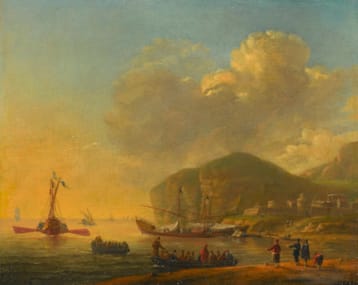
einier Nooms, called Zeeman
(Amsterdam 1623 - Amsterdam 1664)
 Biography
Biography Shipping before a Mediterranean Coast with a Fortified Town near a Cliff
Biography
Nooms was a Dutch painter, draughtsman and etcher. He was probably self-taught as an artist, since much of his early career was spent as a sailor on Dutch merchant vessels, travelling the major Dutch trade routes to Paris, Italy and the North African coast. His works frequently depict marine scenes and coastal views of the ports he visited. Throughout his career he proudly identified himself by the surname ‘Zeeman’ (Dut.: ‘Seaman’), by which title he regularly signed his works. He is now known principally as a painter of ships, whose work falls within the last two stylistic phases of 17th-century Dutch Marine painting. Some of his paintings demonstrate the interest in light and atmosphere that typified the mid-century ‘tonal’ phase and can be seen in the work of Willem van de Velde the elder. Other works, such as Nooms’s views of sea battles and Italian ports, have a romantic character that anticipates the more dramatic style of the late 17th century.
Nooms’s paintings of ships are full of accurate detail, demonstrating the keen eye and understanding of a professional sailor in his delineation of hull and rigging. Often he painted a vessel from several angles, allowing the viewer to experience its various aspects, and frequently included the everyday activities of sailors in the scene. For example, Marine (c. 1650–52; Rotterdam, Museum Boymans–van Beuningen) shows the three-masted warship Het Wapen van Amsterdam lying on its side in the shallow water of an Amsterdam shipyard, while, from a raft, labourers work at caulking the underside of the hull with tar. This motif became a hallmark of his numerous Dutch harbour views.
Nooms painted harbour views of Paris, Venice, Tunis, Tripoli, Algiers and Syracuse, as well as such Dutch cities as Zaandaam and his native Amsterdam. These, like his ship scenes, are characterized by close observation of detail. The small figures lining the shore often engage in activities typical of seaport life, such as loading and unloading cargo or repairing vessels at anchor. The latter are generally Dutch—emphatic patriotic symbols of mercantile power and of a prosperous trading empire. He also painted several of the major naval battles of his time, some of those in the Mediterranean probably from life, although his best-known example, the Naval Battle of Livorno, 14 March 1653, depicting the Dutch victory over the English, is probably based on contemporary accounts.
Nooms was also distinguished as an etcher. Among his 170 plates are two etched series of views of Amsterdam: Verscheyde schepen en gesichten van Amsterdam (‘Various ships and views of Amsterdam’; b. 53–98) and Nieuwe en eugententlycke afbeeldinghe der stads-poorten van Amsterdam (‘New and original representations of the city gates of Amsterdam’; b. 119–26). These accomplished prints are among the first to concentrate on accurate rendering of architecture and were forerunners of the townscapes that were produced prolifically in the 18th century. He also made a series of views of the Louvre in Paris, which, two centuries later, inspired the French artist Charles Méryon.
Collections
Nooms is represented in the following collections: Fine Arts Museums of San Francisco; Louvre Museum, Paris; Rijksmuseum, Amsterdam; Cleveland Museum of Art, Ohio; Courtauld Institute of Art, London, UK; Harvard University Art Museums, Massachusetts; Hunterian Museum and Art Gallery, University of Glasgow, Scotland; National Maritime Museum, Greenwich, UK, amongst others.









